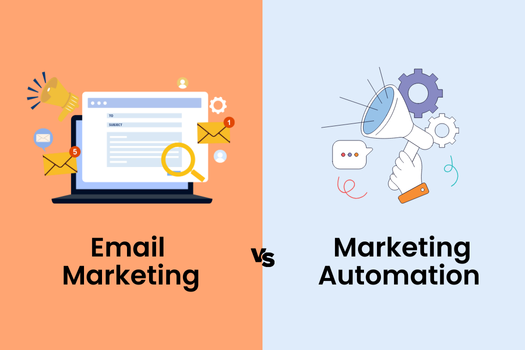B2B content marketing isn’t about quick wins but building lasting relationships and providing consistent value.
Whether it’s educational blog posts, data-driven reports, or immersive virtual events, the most successful B2B companies focus on creating content that resonates with their audience and aligns with their business objectives.
But creating effective B2B content that captures attention, builds trust, and drives results isn’t always easy. Today, 91% of B2B marketers use content marketing, but only 29% consider their efforts highly successful (Source: Content Marketing Institute).
This blog’ll highlight some successful B2B content marketing examples and break down the key strategies behind their success. Whether you’re a marketer, business leader, or entrepreneur, you’ll find plenty of inspiration for your next content campaign.
Why B2B Content Marketing Matters?
Today's B2B buyers are no longer dependent on salespeople for information. 73% say they prefer to research independently before engaging with a sales representative.
This behavior shift means buyers spend a significant amount of time reading blog posts, industry reports, case studies, and watching videos to educate themselves on solutions that meet their specific needs.
They compare competitors, evaluate pricing models, and read reviews—all before initiating direct contact with a company.
This is why content marketing has become crucial in the B2B space. It positions companies as industry leaders and trusted resources, helping buyers make more informed decisions.
Instead of relying on cold outreach and traditional sales tactics, successful B2B companies build long-term relationships through content marketing services such as blog creation, white papers, case studies, video content, email marketing, and SEO strategies that educate and nurture their prospects.
Here are some of the key benefits of an effective B2B content marketing strategy:
-
Builds Brand Authority and Thought Leadership: Creating high-quality, insightful content helps establish your brand as a knowledgeable leader in your field. When your content consistently provides answers and guidance, your audience begins to trust your expertise.
-
Generates and Nurtures Leads: By offering valuable content at every stage of the buyer’s journey, you can attract leads and guide them from awareness to consideration and finally to the decision stage. Content like white papers, case studies, and webinars can help nurture these leads over time.
-
Improves Customer Retention: Content isn’t just for attracting new customers—it’s also a powerful tool for keeping your existing ones engaged. Regularly publishing helpful resources can enhance the customer experience, ensuring they continue to see value in your brand. When combined with effective conversion rate optimization (CRO) strategies, your content can drive deeper engagement and encourage repeat conversions.
-
Shortens the Sales Cycle: B2B purchases are often complex, involving multiple stakeholders. When content addresses common objections, educates decision-makers, and communicates ROI, it can speed up decision-making and close deals faster.
The foundation of effective B2B content marketing lies in understanding your target audience. Who are they? What challenges are they facing? What solutions are they seeking? When you deliver content that addresses these pain points clearly and engagingly, you’ll create meaningful connections with your audience.
Boost Engagement & Build Lasting B2B Relationships
Move beyond cold outreach and outdated sales tactics. With strategic content marketing services—you can educate, nurture, and convert your prospects into loyal customers.
Examples of B2B Content Marketing That Lead the Way
Now, let’s explore how some of the world’s leading B2B companies have taken these principles and created inspiring content marketing strategies that deliver real results.
1. HubSpot: A Masterclass in Educational Content
Strategy: Blogs, Guides, and a Content Hub
HubSpot is widely known as one of the pioneers of inbound marketing. Their content marketing strategy is providing educational content through blogs, eBooks, templates, and webinars. They cover topics like marketing automation, sales strategies, and customer experience to help businesses grow.
Why It Works:
-
SEO-Focused Content: HubSpot ranks for thousands of relevant keywords, generating significant organic traffic.
-
Value-Driven: Every content is designed to solve a specific business challenge.
-
Multiple Content Formats: They cater to learning preferences with videos, templates, and interactive tools.
Key Takeaway:
Educational content can build trust and authority. Help your audience succeed by providing valuable resources that solve their pain points.
2. LinkedIn: Data-Driven Reports for Thought Leadership
Strategy: Industry Reports and Benchmark Studies
LinkedIn’s B2B Marketing Benchmark Report is a perfect example of how data-driven content can establish authority. The report offers insights into marketing trends and benchmarks, helping marketers make data-informed decisions.
Why It Works:
-
Exclusive Insights: LinkedIn marketing leverages vast data to deliver unique, relevant insights.
-
Credibility: Data-driven content positions LinkedIn as a thought leader.
-
Visually Appealing: Well-designed graphics and visual storytelling make the data easy to digest.
Key Takeaway:
Use data to create high-value reports and white papers that establish your brand as an authority in your field.
3. Slack: Customer-Centric Storytelling
Strategy: Video Testimonials and Case Studies
Slack’s content marketing focuses on real-world examples of companies using its collaboration platform to improve workflows. Slack highlights how it solves common business problems through customer stories and video testimonials.
Why It Works:
-
Humanizes the Brand: Storytelling makes the product relatable and easy to understand.
-
Emotional Connection: Video content brings a human touch to B2B marketing.
-
Social Proof: Real customer success stories build trust.
Key Takeaway:
Use storytelling to demonstrate your product’s value in real-life scenarios. Video testimonials can be especially powerful.
4. Salesforce: Virtual Events and Interactive Content
Strategy: Virtual Conferences and Interactive Tools
Salesforce’s Dreamforce event is a gold standard for B2B events. When the pandemic forced in-person events online, Salesforce quickly adapted by creating interactive virtual experiences. Attendees could access live demos, Q&A sessions, and network virtually.
Why It Works:
-
Community Building: Events foster a loyal community around the brand.
-
Interactive Experiences: Live content and on-demand sessions keep engagement high.
-
Repurposed Content: Event content is repurposed into webinars and blog posts, maximizing reach.
Key Takeaway:
Interactive content—whether through virtual events, quizzes, or calculators—can enhance engagement and deliver long-term value.
5. Deloitte: Purpose-Driven Storytelling
Strategy: Branded Content and Thought Leadership
Deloitte focuses on purpose-driven content that aligns with its brand values. Their content covers sustainability, innovation, and leadership, positioning the company as a forward-thinking advisor.
Why It Works:
-
Authentic Storytelling: Real stories illustrate how Deloitte helps businesses thrive.
-
Cross-Channel Distribution: Content is shared across blogs, podcasts, and social media.
-
Thought Leadership: Deloitte’s reports and insights set the agenda for industry conversations.
Key Takeaway:
Embrace storytelling with purpose. Share content that reflects your brand’s values and mission to connect with your audience on an emotional level.
6. Adobe: User-Generated Content and Creative Campaigns
Strategy: Social Media Campaigns and UGC
Adobe’s #AdobeForAll and #AdobeMAX campaigns are prime examples of user-generated content (UGC) done right. By integrating UGC into its social media marketing strategy, Adobe encourages users to share their work, tapping into the creativity of its audience while building a strong sense of community and increasing brand visibility.
Why It Works:
-
Authenticity: UGC is more relatable and trustworthy than branded content.
-
Community Building: Adobe fosters loyalty by celebrating its users.
-
Multi-Channel Promotion: Content is shared across social media, reaching a wider audience.
Key Takeaway:
Incorporate UGC into your strategy to boost engagement and build community around your brand.
7. General Electric (GE): Science and Innovation Content
Strategy: Branded Storytelling and Social Media
General Electric (GE) creatively approaches B2B content marketing by focusing on science and innovation storytelling. Their GE Reports blog covers the latest technological advancements in healthcare, energy, and aviation. GE shares stunning visuals and videos on social media to showcase its innovations.
Why It Works:
-
Focus on Innovation: GE highlights cutting-edge projects, positioning itself as a leader in technology.
-
Visual Content: Eye-catching images and videos make complex topics more engaging.
-
Human Element: GE’s content often focuses on the people behind the innovations, creating an emotional connection.
Key Takeaway:
Make complex topics accessible through storytelling and visual content. Focus on the human impact of your innovations.
Practical Tips for Your B2B Content Marketing Strategy
Now that we’ve explored some inspiring examples, it’s time to apply those insights to your strategy. Here are detailed steps to help you build a successful B2B content marketing plan:
1. Define Clear Goals
Knowing what you want to achieve is the first step in any successful strategy. Without clear goals, it’s impossible to measure success. Ask yourself:
-
Are you trying to generate leads? If so, focus on creating gated content like eBooks, white papers, and webinars to capture contact information.
-
Is your priority building brand awareness? To increase visibility, prioritize thought leadership content, blogs, and social media.
-
Do you want to improve customer retention? Consider creating customer-focused content like how-to guides, newsletters, and case studies that help current clients get the most out of your services.
Once you’ve defined your goals, ensure your content strategy aligns with them. For example, if lead generation is your goal, track metrics like form submissions and lead conversion rates to evaluate success.
2. Understand Your Audience
Knowing your audience is essential for creating content that resonates. To do this, develop detailed buyer personas, and semi-fictional representations of your ideal customers based on research and data.
When building a buyer persona, consider factors like:
-
Job title and role: Are they decision-makers or influencers?
-
Pain points: What challenges are they facing that your product or service can solve?
-
Preferred content formats: Do they prefer in-depth white papers or short videos?
-
Channels: Where do they consume content—LinkedIn, industry blogs, email?
By understanding your audience’s needs and preferences, you can create highly targeted content that addresses their specific challenges and offers valuable solutions.
3. Diversify Content Formats
Not all of your audience consumes content in the same way. To keep your audience engaged, offer a mix of content formats. Here’s how you can diversify:
-
Blogs: Great for building organic traffic and sharing thought leadership.
-
Videos: Ideal for engagingly explaining complex ideas.
-
Case Studies: Demonstrate your product’s value through real-world success stories.
-
Webinars: Provide in-depth education and live interaction with prospects.
-
Interactive Tools: Quizzes, calculators, and assessments boost engagement and deliver personalized value.
The more diverse your content offering, the better chance you have of capturing and holding your audience’s attention across different platforms and touchpoints.
4. Leverage SEO for Discoverability
Creating great content is only half the battle—you must ensure it’s easily discoverable. This is where Search Engine Optimization (SEO) plays a critical role. By optimizing your content for relevant keywords, you can improve your search rankings and drive organic traffic to your site.
Tips for improving SEO:
-
Keyword Research: Identify keywords your audience is searching for and incorporate them naturally into your content.
-
On-Page SEO: Optimize titles, headers, meta descriptions, and images.
-
Internal Linking: Link to relevant content on your site to improve navigation and boost SEO.
-
Create Evergreen Content: Content that stays relevant over time will continue attracting traffic long after publication.
SEO isn’t a one-time effort. You should regularly update and refine your content based on performance metrics and keyword trends.
5. Repurpose Content
Creating new content from scratch can be time-consuming and costly. One of the most effective ways to maximize your content’s value is by repurposing it into different formats.
Examples of repurposing content:
-
Turn a blog post into a video series.
-
Convert a webinar into an eBook.
-
Create an infographic from a research report.
-
Break long-form content into bite-sized social media posts.
Repurposing extends the lifespan of your content, allowing you to reach new audiences and reinforce your message across multiple channels without reinventing the wheel.
Conclusion
By following these practical steps, you’ll be well on your way to building a more robust and effective B2B content marketing strategy.
The key is to stay focused on your audience’s needs, continuously measure your performance, and adapt your strategy as you learn what works best. Remember, content marketing is a long-term game, but it can deliver significant returns with a thoughtful approach.
If you’re looking for the same results, Saffron Edge is a leading saas content marketing agency that can help you enhance your online presence and drive measurable growth. Contact Us Today!
Get The Ultimate Marketing Toolkit
Frequently Asked Questions
What is B2B content marketing, and why is it important?
B2B content marketing focuses on creating valuable content to engage business buyers. It’s crucial because B2B buyers conduct extensive research before making decisions. High-quality content helps build trust, generate leads, and establish your brand as an industry authority, ultimately influencing purchasing choices.
What types of content work best for B2B marketing?
Effective B2B content includes blogs for thought leadership, case studies for real-world examples, white papers for in-depth insights, videos for engaging explanations, and webinars for live education. Diversifying formats ensures you capture the attention of different audience segments.
How can I measure the success of my B2B content marketing strategy?
Success is measured by tracking KPIs like website traffic, lead generation, engagement metrics, and conversion rates. Tools like Google Analytics and HubSpot can help monitor performance and ensure your content strategy meets its goals.
How do I create a buyer persona for my B2B content strategy?
Research your audience’s job roles, pain points, and content preferences to create a buyer persona. Use surveys, interviews, and data analysis to document their needs and challenges, which will help tailor your content to address their specific problems.
What are some common mistakes to avoid in B2B content marketing?
Avoid common mistakes like publishing without a clear strategy, ignoring SEO, or creating overly promotional content. Understand your audience, provide value, and continuously analyze your content performance to improve results.
Level Up Your B2B Content Strategy
Engage your audience, generate leads, and boost conversions with the right content marketing strategy. Avoid common mistakes, create content that resonates, and measure success effectively.
Related Blogs
We explore and publish the latest & most underrated content before it becomes a trend.
7 min read
Email Marketing vs. Marketing Automation: Which Strategy is Right for You?
By Sabah Noor4 min read
Top 6 Benefits of Marketing Automation You Need To Know
By Vibhu Satpaul7 min read
ROAS Marketing for B2B: Proven Strategies for Higher Returns in 2025
By Sabah Noor
Subscribe to Saffron Edge Newsletter!

Get The Ultimate Marketing Toolkit










